|
The Shushan Covered Bridge Museum
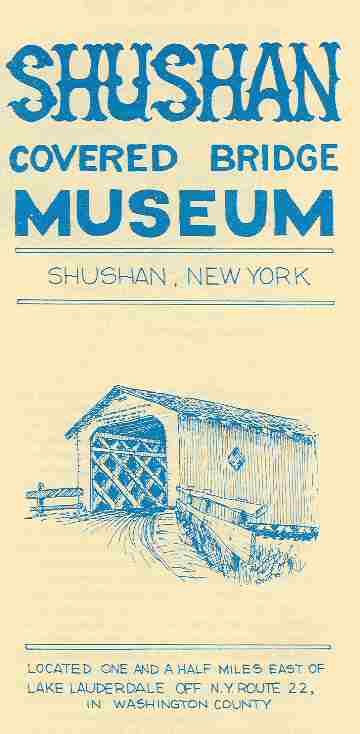 |
Museum Hours: 1:00 to 4:00 p.m.
Spring Season (Memorial Day to July 4th)
Open on weekends only.
Summer Season (July 4th to Labor Day)
Open daily except Mondays.
Fall Season (Labor Day to Columbus Day)
Open on weekends only.
Admission Free
Donations Gratefully Accepted |
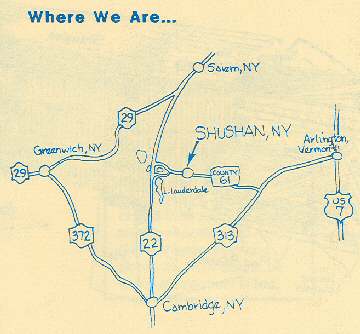 |
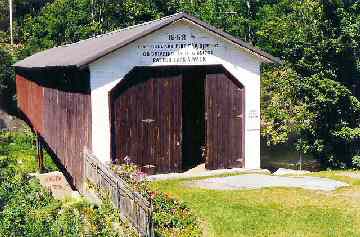 |
Shushan Bridge in Summer.
Photo by Dick
Wilson |
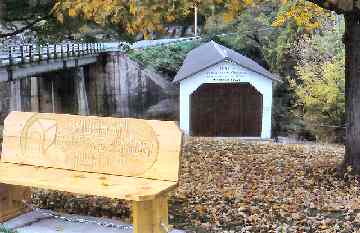 |
Shushan Bench.
Photo by Dick
Wilson |
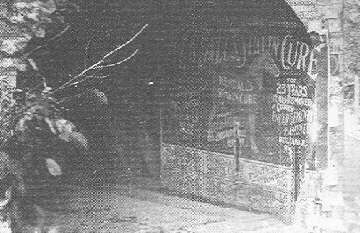 |
Shushan posters.
Photo from November 1994
NYSCBS Bulletin |
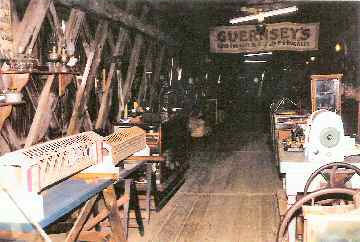 |
Shushan Bridge Museum exhibits.
Photo by Dick
Wilson |
Seekers after the ubiquitous covered bridges of southern Vermont and the Battenkill
must not miss visiting the Shushan Covered Bridge Museum in Shushan, New York, just over the
Vermont /New York border.
This extraordinary little museum not only preserves a
mid-eighteenth century example of covered bridge construction, it memorializes the way of life of
a small village of the Northeast. More than that, it demonstrates what a small group of determined
people can do for their community.
THE SHUSHAN COVERED BRIDGE ASSOCIATION*
The Shushan Covered Bridge Association was
organized in 1974 when it acquired the covered bridge from the Washington County Highway
Department. In danger of imminent collapse due to rain damage caused by a badly leaking roof,
the bridge was shored up by the efforts of dozens of volunteers rushing to the rescue. Their
donations of time, money and talent saved the old span.
The Shushan Covered Bridge Museum was opened in
1975, born with the idea that the old bridge, itself the main attraction, would house an ever-
changing display of pieces on loan from all over this rural region. There are many old farms in
Washington County that have agricultural implements, tools and domestic utensils from an earlier
time that would be of interest to museum-goers of all ages. Old mills and factories yield up an
item or two of historic value from time to time. Many pieces have been donated to the Museum,
but most of what is displayed is on loan.
The Museum's directors feel that the items should be
put in working order whenever possible and demonstrated, rather than merely being displayed.
This is done on Harvest Day in August of each year.
The Shushan Covered Bridge Association operates
the Museum and staffs it with one or more volunteers every day of the season. These "bridge
tenders" will gladly assist you and try to answer any questions you may have about the Museum
and its displays.
The Association membership numbers about 300 and
is open to all who wish to join. Permanently chartered by the New York State Board of Regents
as a private, not-for-profit organization, the Association is tax-exempt. Any contributions to the
Museum and the Association are tax-deductible.
[© Shushan Covered Bridge Association, Inc. Shushan, New York 12873]
THE SHUSHAN BRIDGE AND THE SCHOOLHOUSE*
The Shushan Covered Bridge was built during
the spring and summer of 1858 under the direction of brothers Milton and Andrew Stevens. It is
of Town Lattice construction, 161 feet in length, having 46 panels. each 3-1/2 feet on centers. All
truss timbers are either white pine, spruce or hemlock fastened at the joints by trunnels of either
red oak or locust. Primary chords are made up of 3 x 12 inch plank, with secondary chords and
web pieces of 3 x 10 inch plank. Full chord sticks subtend a distance of eight panels, or 28 feet.
The roadway is 16 feet wide. carried on 8 x 12 inch floor beams spaced every seven feet. Eight
longitudinal floor joists carry two thicknesses of two-inch random-width floor planks.
The bridge trusses were laid out and assembled on the
village green beside the railroad depot, then taken apart and reassembled over the river on a
system of falsework. The total weight of the bridge. including roof and side covering, is estimated
at 80 tons.
Although posted for a safe load of five tons when it
was bypassed in 1963, it has been estimated that it could have continued to carry six times that
amount without trouble. Only 11 ensuing years of neglect of a leaking roof allowed the upper
chords to be damaged. leading to the near-collapse of the span in 1974. Timely repairs and the
reinstalling of a center pier allow the structure to continue in the limited duty now imposed upon
it. The bridge was bypassed mainly to improve traffic conditions at the road approaches.
The Town Lattice truss design was one of about 20
wooden bridge truss types developed during the 19th Century. Patented January 1, 1820 by Ithiel
Town. an architect from Bridgeport, Connecticut, it was extensively promoted by him throughout
the South. By 1840 it had become one of a few standard types chosen by local builders because of
its ease of construction by ordinary carpenters.
Although Ithiel Town is generally credited with
having invented this form of truss, there is an engineering tradition that says the first examples
were built in and around Pittsford or Brandon, Vermont as early as 1812. That these initial efforts
were quite crude, there is no question. It was left to Town to seize upon the idea, develop it and
further improve it during the 1830s.
A few yards from the bridge entrance stands a one-
room schoolhouse. Built on land donated by the Law family, it was in continuous use as a
schoolhouse from 1852 to 1943. Known variously as the Lower Camden School or the White
School, it was officially District School No.6 of the Town of Salem. When it was closed the
property reverted to the descendants of the Law family. It was purchased later by J. Edward
Hawes and presented to the Shushan Covered Bridge Museum. The school was moved to its
present site in 1979 and opened for visitors in 1981. It is now furnished with desks and texts from
the 19th Century.
[*Text taken from Shushan Covered Bridge Association, Inc. brochure]
HOW THE MUSEUM CAME TO BE
[from Shushan Old Home Day Booklet, 1977]
March 18, 1974 - Shushan Grange held an open meeting to discuss the future of the
abandoned covered bridge. Three possibilities were presented: (1) let it continue to decay,
eventually falling into the Battenkill, as a relic of bygone days, no longer needed; (2) seek a
market for the bridge, to be dismantled and removed; (3) form an organization whose purpose
would be to preserve and restore the bridge, perhaps developing it as a museum of local artifacts,
agricultural and household articles. A business man volunteered to move the bridge and use it as
the entrance to a cosmetic factory. His offer was tabled.
It was reported by Jackson Supervisor Emerson
McLenithan that the highway committee of the Washington County Board of Supervisors, still
responsible for the covered bridge although it was no longer a roadway, was sympathetic to the
idea of a museum, and was willing to put the bridge into possession of a committee for that
purpose. The group taking possession must be organized and preferably incorporated.
Carleton Foster of Cambridge was elected to choose a
committee of six to proceed with incorporation of the Shushan Covered Bridge Association, the
new organization, and with the Grange offering a meeting place, the first step to the museum was
taken. Thus the dream of Mary Buffum Hamlin began to materialize.
April 5, 1974 - June 11, 1974 - Attorney Richard McLenithan volunteered his
services in securing letters of incorporation as a non-profit organization. The committee decided
against seeking government aid, available for historical preservation' and educational projects, to
avoid the inevitable red tape of regulations and demands on the part of the State in such
situations. As an alternative, the Association would offer memberships. Funds for roof repair were
the prime necessity.
The steering committee set the cost of a membership
in the Shushan Covered Bridge Association as one dollar per year. Inspection of the bridge
revealed the floor to be sound, the roof in bad condition.
The application for incorporation was signed and
notarized, to be sent to the Washington County Board of Supervisors' transportation
committee.
The question arose at the meeting of the Shushan
Covered Bridge Association as to the extent of land to be included in the expected deed to the
bridge. Shushan Grange announced a benefit card party. Other fund-raising ideas proposed
included postcards, notepaper, china plates and tiles of the bridge, serving refreshments at
auctions.
The Association was informed that the Washington
County Board of Supervisors planned to give a Quit Deed to the organization on June 17, and in
addition would repair the approach to the bridge. The papers of incorporation were in the hands
of Judge Robert Bascom. There was now '$166.20 in the treasury. The value of the structure was
set at $40,000.
Niagara Mohawk Power Corporation was reported as
willing to have their land at the Town of Jackson end of the bridge used as a picnic area.
A "glaze-in" was held at the home of Bob and Carol
Rich, to decorate plates, mugs and tiles for sale.
July 2, 1974 - August 6,1974 - A delay in granting letters of incorporation was
announced, due to. the jurisdictional claim of the New York State Department of Education to
make the decision. Reason: the Association had mentioned that the organization would be
educational as well as historical!
The Association participated in the Rotary Club, Flea
Market at Salem, paying a fee of $10. The sale of ceramics and commissions on paintings raised
the treasury balance to. $455.10 beside generating some helpful publicity.
The slate of officers presented by the nominating
committee was elected.
August 11, 1974 - September 21,1974 - The New York State Covered Bridge
Society met in Shushan. The local organization showed a film (made by Bettie Bryant, with Peter
H. Clark at the projector) of the moving of the Jackson end of the covered bridge to. its present
site.
A gift of $300 from the New York State Covered
Bridge Society was received. The amount in the treasury was now $756.33. A letter from the
New York State Department of Education denied letters of incorporation, and instructed the
Association to apply for a charter from the Regents of the State of New York.
Upon report of Supervisor Robert Thompson of
Salem that a Utica expert estimated damage to. the covered bridge, mostly from wind, might be
$100,000, the Association discussed plans to raise money for repairs such as soliciting funds
locally and from the National Registry of Historic Buildings.
September 5,1974 - October 29, 1974 - The executive committee met with the
County Board of Supervisors at Fort Edward, and found the county engineer interested and the
Board sympathetic.
In the event the County advertised the Shush an
covered bridge for demolition or preservation, the Association decided to bid $6000.
Volunteers, professional and amateur, met at the
bridge to. begin repairs, in the presence of a State engineer as an advisor.
J.R. Rich Enterprises, Inc., representing the Shushan
Covered Bridge Association, placed a bid of $6000 to repair the covered bridge. The only other
bid (for demolition) was $26,000. On the same date application was made to the New York State
Board of Regents for a charter.
J.R. Rich Enterprises, Inc., took Possession of the
Shushan covered bridge, in trust for the Shushan Covered Bridge Association, and the deed was
filed. Volunteers labored every Saturday, constructing a steel and concrete pier under the
bridge, jacking up the sagging bridge at a few inches per week.
Unpaid bills for 38 yards of concrete, lumber, welding
were presented. A signed voucher for $6000 was returned to the County. Letters of gratitude
were sent to volunteers who worked faithfully on construction of the new pier, and to. welders
who either charged nothing for their services or cut their charges drastically.
November 17,1974 - December 31, 1974 - Before a public gathering at the Shushan
covered bridge John R. Rich of Rich Enterprises, Inc., formally turned over the deed to the newly
chartered Shushan Covered Bridge Association. Carleton Foster, president, accepted the deed.
The supervisors of the two townships linked by the old bridge observed the ceremony:
Emerson McLenithan of Jackson and Robert Thompson of Salem. Several other members of the
Washington County Board of Supervisors witnessed the event.
The treasury, bolstered by payment by Washington
County for the Association's bid on repairs, was $5,157.68.
March 4, 1975 - May 6, 1975 - The Shushan Covered Bridge Association filed a
request for designation as a tax-exempt organization.
The sagging roof of the covered bridge was reported
straightened, and trusses were under repair. The Association applied for a grant from Bird & Son,
Inc. of East Walpole, Mass. This company grants matching funds for projects approved by their
judges.
Members met at the bridge to scrub and clean after
tne years of neglect.
The New York State Covered Bridge Society met in
Grange Hall and visited the covered bridge to note repairs completed and assess those stilI
required. The Society presented the Shushan Association with a gift of $250 toward preservation
of the bridge.
June 28, 1975 was set as the target date for opening
the Shushan Covered Bridge Museum.
June 28, 1975 The dream, through imagination, patience and dedicated work,
became a reality. Shushan Covered Bridge Museum was opened to the public with a parade of
antique cars, a high wheel bicycle, horse-drawn surreys, buggies, wagons. Several members of the
Cambridge band volunteered sprightly music from the top of Rich's Linn Haven Highway
Pullman.
After suitable speeches the ribbon was cut by Mrs. Ida
Boice whose grandfather had helped erect the covered bridge in 1858.
During that first season about 900 visitors walked
through the exhibits of machinery, photographs, old plows, butter churns and the like, coming to
Shushan from 26 States and six foreign countries.
In its third season, repairs, the generous lending of
exhibits, and the growing numbers of visitors continue. The Shushan Covered Bridge Association
is a going concern, solvent, but depending on its widening membership to continue the upward
curve in the value of their previous landmark.
|
 Joe Nelson, P.O Box 267, Jericho, VT 05465-0267
This file posted March 24, 2004
Joe Nelson, P.O Box 267, Jericho, VT 05465-0267
This file posted March 24, 2004





